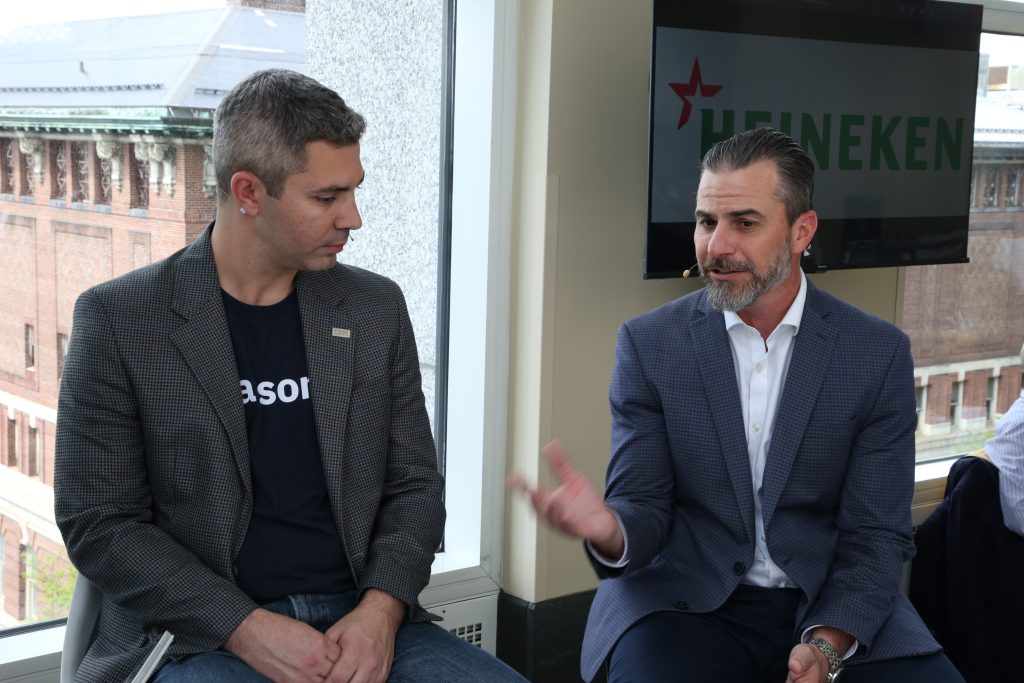Long-term success in AI depends on a robust hybrid data architecture that adapts to where data resides and how it’s used.
IBM Corp.is fully embracing this strategy, and the results so far have been promising. The company reports early wins that hint at massive future gains, with expectations that current successes could multiply significantly over time, according to Ed Calvesbert (pictured, right), vice president of product management for IBM watsonx.data at IBM.

IBM’s Ed Calvesbert talks with theCUBE about the company’s strategy around data, hybrid infrastructure and governance.
“It’s going to transform technology. It’s going to transform business across many, many different sectors.” he said. “On top of that … IBM’s never been more ecosystem forward and the quality of the partners that are coming in, even competitors that are participating in the ecosystem; that’s going to be so beautiful.”
Calvesbert and Scott Brokaw (left), vice president of product and data integration at IBM, spoke with theCUBE Research’s Dave Vellante at IBM Think, during an exclusive broadcast on theCUBE, SiliconANGLE Media’s livestreaming studio. They discussed IBM’s strategy for bridging structured and unstructured data, the role of hybrid infrastructure in AI adoption and how governance shapes business outcomes. (* Disclosure below.)
From hybrid data architecture to governance: IBM’s AI strategy in action
IBM underscores the need to unlock value from unstructured data, which remains untapped mainly across the enterprise, according to Calvesbert. Most analytics workflows prioritize structured data alone, leaving a wide gap in what’s actually used. The company’s strategy centers on unifying structured and unstructured sources through watsonx.data.
“You get a lot better accuracy, which means you can do more use cases,” he said. “It’s not just about information retrieval now. It’s analytical. It’s operational. That’s the next generation of agents and apps. That’s number one. Number two, you unlock all that unstructured data for traditional lakehouse workloads, business intelligence, data engineering [and] machine learning.”
That emphasis on integration extends to infrastructure. IBM’s hybrid data architecture stands out for delivering consistent performance across on-prem, cloud and hybrid environments, without forcing enterprises to uproot data, according to Brokaw.
“Data workloads belong where data actually is,” he added. “Why are you going to move data just to be able to do transformation or processing or analytics? We should be pushing those functions ultimately to where the data resides. Not only is it because egress costs are really high, but locality costs data, prominence costs, being able to actually run where the data is … should be in every client’s first order of purge.”
Governance becomes the glue that holds the hybrid data architecture together, not just as policy, but as infrastructure. IBM’s approach blends rich metadata, semantic enrichment and lineage capabilities, emphasizing cultural readiness. Rather than focusing solely on technology, the company highlights the human factors that often make or break governance initiatives. In hybrid environments where data is distributed, governance plays a central role in enabling insight generation, trust and compliance, according to Brokaw.
“When you think about data governance, you have to establish first there’s people, process and technology,” he said. “A lot of organizations struggle with the people and process, even before they get to the technology. A lot of people think about data governance, and they think like a cop looking to say, ‘Hey, you can’t access a particular data set.’ They underappreciate the ability that data governance can actually be an enabler. It can allow your companies to be more data-driven.”
Here’s the complete video interview, part of SiliconANGLE’s and theCUBE’s coverage of IBM Think:
(* Disclosure: TheCUBE is a paid media partner for IBM Think. Neither IBM Corp., the sponsor of theCUBE’s event coverage, nor other sponsors have editorial control over content on theCUBE or SiliconANGLE.)
Photo: SiliconANGLE
Your vote of support is important to us and it helps us keep the content FREE.
One click below supports our mission to provide free, deep, and relevant content.
Join our community on YouTube
Join the community that includes more than 15,000 #CubeAlumni experts, including Amazon.com CEO Andy Jassy, Dell Technologies founder and CEO Michael Dell, Intel CEO Pat Gelsinger, and many more luminaries and experts.
THANK YOU

